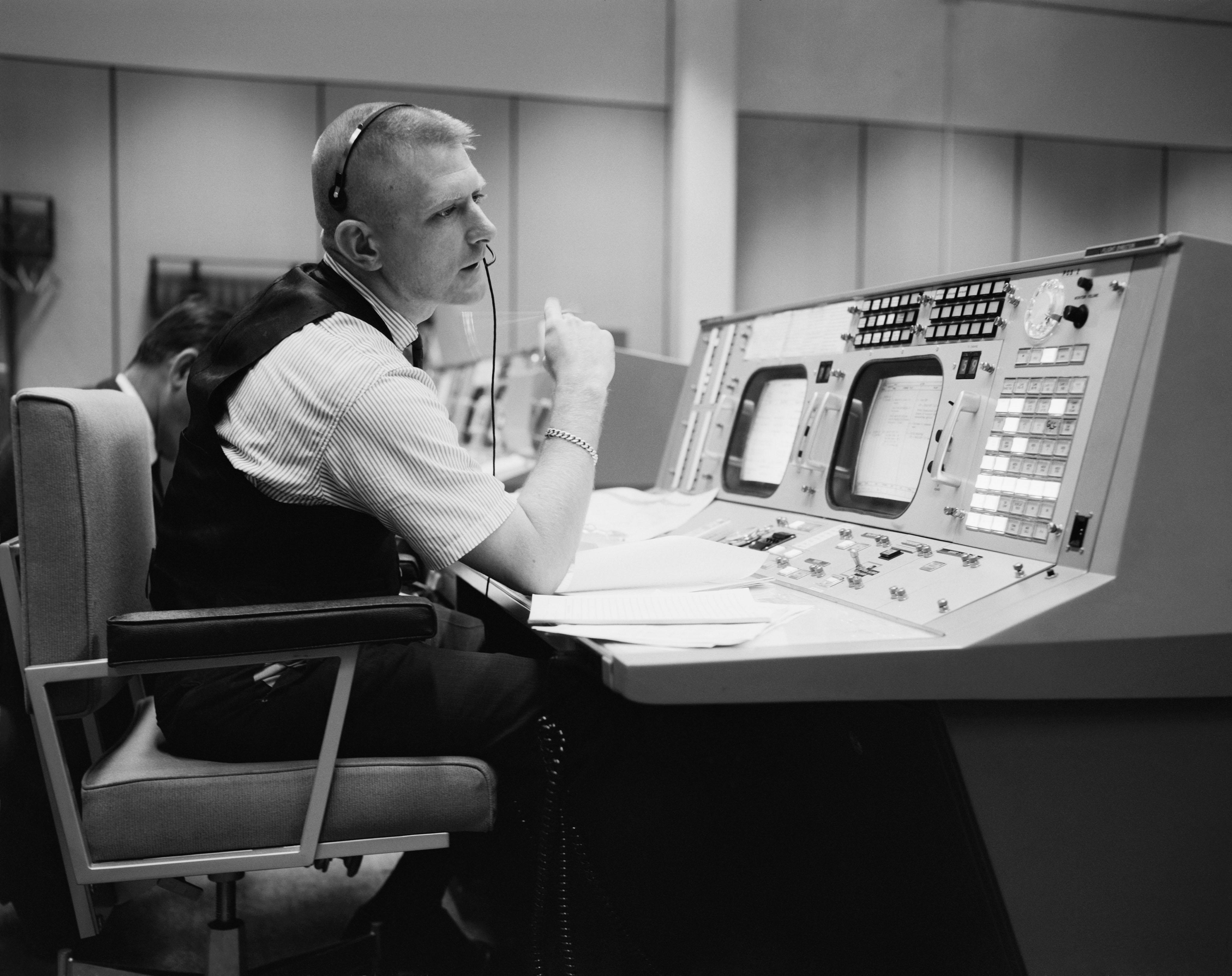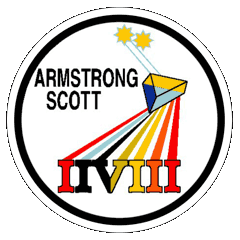|
Jack Garman
John Royer "Jack" Garman (September 11, 1944 – September 20, 2016) was a computer engineer, former senior NASA executive and noted key figure of the Apollo 11 lunar landing. As a young specialist on duty during the final descent stage on 20 July 1969 he dealt with a series of computer alarms which could have caused the mission to be aborted. Early life Garman was born September 11, 1944, in Oak Park, Illinois, and attended the University of Michigan in Ann Arbor. He graduated in 1966 with a Bachelor of Science degree in Engineering Physics and a specialty in Computing. NASA career In 1966, at age 21, Garman was hired by NASA. He chose to specialize in onboard computing and was assigned to the Apollo Guidance Program Section where he worked with MIT, supervising the design and testing of the Apollo Guidance Computer. During the Apollo missions Garman worked in a support role, advising flight controllers in Mission Control on the operation of spacecraft computer systems. A f ... [...More Info...] [...Related Items...] OR: [Wikipedia] [Google] [Baidu] |
Oak Park, Illinois
Oak Park is a village in Cook County, Illinois, adjacent to Chicago. It is the 29th-most populous municipality in Illinois with a population of 54,583 as of the 2020 U.S. Census estimate. Oak Park was first settled in 1835 and later incorporated in 1902, when it separated from Cicero, Illinois, Cicero. Architect Frank Lloyd Wright and his wife settled in Oak Park in 1889, and his work heavily influenced local architecture and design, including the Frank Lloyd Wright Home and Studio. Over the years, rapid development was spurred by railroads and street cars connecting the village to jobs in nearby Chicago. In 1968, Oak Park passed the Open Housing Ordinance, which helped devise strategies to integrate the village rather than resegregate. Today, Oak Park remains ethnically diverse, and is known for its socially liberal politics, with 80% or higher voter turnout in every United States presidential election, presidential election since 2000. Oak Park is closely connected to Chicago with ... [...More Info...] [...Related Items...] OR: [Wikipedia] [Google] [Baidu] |
Lunar Module Eagle
Lunar Module ''Eagle'' (LM-5) is the spacecraft that served as the crewed lunar lander of Apollo 11, which was the first mission to land humans on the Moon. It was named after the bald eagle, which was featured prominently on the mission insignia. It flew from Earth to lunar orbit on the command module ''Columbia'', and then was flown to the Moon on July 20, 1969, by astronaut Neil Armstrong with navigational assistance from Buzz Aldrin. ''Eagle''s landing created Tranquility Base, named by Armstrong and Aldrin and first announced upon the module's touchdown. The name of the craft gave rise to the phrase "The Eagle has Landed", the words Armstrong said upon ''Eagle''s touchdown. The phrase was used as the title of a best-selling 1975 book, set during the Second World War, and the 1976 film adaptation. Flight ''Eagle'' was launched with command module ''Columbia'' on July 16, 1969, atop a Saturn V launch vehicle from Launch Complex 39A, and entered Earth orbit 12 m ... [...More Info...] [...Related Items...] OR: [Wikipedia] [Google] [Baidu] |
Lockheed Martin
The Lockheed Martin Corporation is an American aerospace, arms, defense, information security, and technology corporation with worldwide interests. It was formed by the merger of Lockheed Corporation with Martin Marietta in March 1995. It is headquartered in North Bethesda, Maryland, in the Washington, D.C. area. Lockheed Martin employs approximately 115,000 employees worldwide, including about 60,000 engineers and scientists as of January 2022. Lockheed Martin is one of the largest companies in the aerospace, military support, security, and technologies industry. It is the world's largest defense contractor by revenue for fiscal year 2014.POC Top 20 Defence Contractors of 2014 . Retrieved: July 2015 In 2013, 78% of Lockheed Martin's revenues came from military sales; [...More Info...] [...Related Items...] OR: [Wikipedia] [Google] [Baidu] |
Johnson Space Center
The Lyndon B. Johnson Space Center (JSC) is NASA's center for human spaceflight (originally named the Manned Spacecraft Center), where human spaceflight training, research, and flight control are conducted. It was renamed in honor of the late US president and Texas native, Lyndon B. Johnson, by an act of the United States Senate on February 19, 1973. It consists of a complex of 100 buildings constructed on in the Clear Lake Area of Houston, which acquired the official nickname "Space City" in 1967. The center is home to NASA's astronaut corps, and is responsible for training astronauts from both the US and its international partners. It houses the Christopher C. Kraft Jr. Mission Control Center, which has provided the flight control function for every NASA human spaceflight since Gemini 4 (including Apollo, Skylab, Apollo–Soyuz, and Space Shuttle). It is popularly known by its radio call signs "Mission Control" and "Houston". The original Manned Spacecraft Center grew out ... [...More Info...] [...Related Items...] OR: [Wikipedia] [Google] [Baidu] |
HAL/S
HAL/S (''High-order Assembly Language/Shuttle'') is a real-time aerospace programming language compiler and cross-compiler for avionics applications used by NASA and associated agencies ( JPL, etc.). It has been used in many U.S. space projects since 1973 and its most significant use was in the Space Shuttle program (approximately 85% of the Shuttle software was coded in HAL/S). It was designed by Intermetrics in 1972 for NASA and delivered in 1973. HAL/S is written in XPL, a dialect of PL/I. Although HAL/S is designed primarily for programming on-board computers, it is general enough to meet nearly all the needs in the production, verification, and support of aerospace and other real-time applications. According to documentation from 2005, it was being maintained by the HAL/S project of United Space Alliance. Goals and principles The three key principles in designing the language were reliability, efficiency, and machine-independence. The language is designed to allow aerospace- ... [...More Info...] [...Related Items...] OR: [Wikipedia] [Google] [Baidu] |
Flight Computer Operating System
Flight or flying is the process by which an object (physics), object motion (physics), moves through a space without contacting any planetary surface, either within an atmosphere (i.e. air flight or aviation) or through the vacuum of outer space (i.e. spaceflight). This can be achieved by generating lift (force), aerodynamic lift associated with gliding flight, gliding or air propulsion, propulsive thrust, aerostatically using buoyancy, or by ballistics, ballistic movement. Many things can fly, from Flying and gliding animals, animal aviators such as birds, bats and insects, to natural gliders/parachuters such as patagium, patagial animals, anemochorous seeds and ballistospores, to human inventions like aircraft (airplanes, helicopters, airships, balloons, etc.) and rockets which may propel spacecraft and spaceplanes. The engineering aspects of flight are the purview of aerospace engineering which is subdivided into aeronautics, the study of vehicles that travel through the atm ... [...More Info...] [...Related Items...] OR: [Wikipedia] [Google] [Baidu] |
Space Shuttle
The Space Shuttle is a retired, partially reusable low Earth orbital spacecraft system operated from 1981 to 2011 by the U.S. National Aeronautics and Space Administration (NASA) as part of the Space Shuttle program. Its official program name was Space Transportation System (STS), taken from a 1969 plan for a system of reusable spacecraft where it was the only item funded for development. The first ( STS-1) of four orbital test flights occurred in 1981, leading to operational flights (STS-5) beginning in 1982. Five complete Space Shuttle orbiter vehicles were built and flown on a total of 135 missions from 1981 to 2011. They launched from the Kennedy Space Center (KSC) in Florida. Operational missions launched numerous satellites, interplanetary probes, and the Hubble Space Telescope (HST), conducted science experiments in orbit, participated in the Shuttle-''Mir'' program with Russia, and participated in construction and servicing of the International Space Station (ISS). ... [...More Info...] [...Related Items...] OR: [Wikipedia] [Google] [Baidu] |
Spacecraft Software Division
A spacecraft is a vehicle or machine designed to fly in outer space. A type of artificial satellite, spacecraft are used for a variety of purposes, including communications, Earth observation, meteorology, navigation, space colonization, planetary exploration, and transportation of humans and cargo. All spacecraft except single-stage-to-orbit vehicles cannot get into space on their own, and require a launch vehicle (carrier rocket). On a sub-orbital spaceflight, a space vehicle enters space and then returns to the surface without having gained sufficient energy or velocity to make a full Earth orbit. For orbital spaceflights, spacecraft enter closed orbits around the Earth or around other celestial bodies. Spacecraft used for human spaceflight carry people on board as crew or passengers from start or on orbit (space stations) only, whereas those used for robotic space missions operate either autonomously or telerobotically. Robotic spacecraft used to support scientific res ... [...More Info...] [...Related Items...] OR: [Wikipedia] [Google] [Baidu] |
Chris Kraft
Christopher Columbus Kraft Jr. (February 28, 1924 – July 22, 2019) was an American aerospace and NASA engineer who was instrumental in establishing the agency's Mission Control Center and shaping its organization and culture. His protégé Glynn Lunney said in 1998: "the Control Center today ... is a reflection of Chris Kraft". Following his 1944 graduation from Virginia Polytechnic Institute and State University with a degree in aeronautical engineering, Kraft was hired by the National Advisory Committee for Aeronautics (NACA), the predecessor organization to the National Aeronautics and Space Administration (NASA). He worked for over a decade in aeronautical research and in 1958 joined the Space Task Group, a small team entrusted with the responsibility of putting America's first man in space. Assigned to the flight operations division, Kraft became NASA's first flight director. He was on duty during America's first crewed spaceflight, first crewed orbital flight, ... [...More Info...] [...Related Items...] OR: [Wikipedia] [Google] [Baidu] |
Flight Controller
Flight controllers are personnel who aid space flight by working in such Mission Control Centers as NASA's Mission Control Center or ESA's European Space Operations Centre. Flight controllers work at computer consoles and use telemetry to monitor various technical aspects of a space mission in real time. Each controller is an expert in a specific area and constantly communicates with additional experts in the "back room". The flight director, who leads the flight controllers, monitors the activities of a team of flight controllers, and has overall responsibility for success and safety. This article primarily discusses NASA's flight controllers at the Johnson Space Center (JSC) in Houston. The various national and commercial flight control facilities have their own teams, which may be described on their own pages. NASA's flight controllers The room where the flight controllers work was called the mission operations control room (MOCR, pronounced "moh-ker"), and now is calle ... [...More Info...] [...Related Items...] OR: [Wikipedia] [Google] [Baidu] |
Neil Armstrong
Neil Alden Armstrong (August 5, 1930 – August 25, 2012) was an American astronaut and aeronautical engineer who became the first person to walk on the Moon in 1969. He was also a naval aviator, test pilot, and university professor. Armstrong was born and raised in Wapakoneta, Ohio. A graduate of Purdue University, he studied aeronautical engineering; his college tuition was paid for by the U.S. Navy under the Holloway Plan. He became a midshipman in 1949 and a naval aviator the following year. He saw action in the Korean War, flying the Grumman F9F Panther from the aircraft carrier . In September 1951, while making a low bombing run, Armstrong's aircraft was damaged when it collided with an anti-aircraft cable, strung across a valley, which cut off a large portion of one wing. Armstrong was forced to bail out. After the war, he completed his bachelor's degree at Purdue and became a test pilot at the National Advisory Committee for Aeronautics (NACA) High-Speed Fligh ... [...More Info...] [...Related Items...] OR: [Wikipedia] [Google] [Baidu] |









